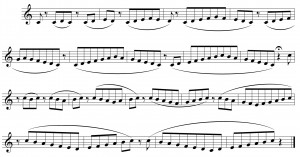This is my mantra with my private and university students. (Actually, one of my many mantras.) Another favorite is: Scales are Useless! -until they’re memorized.
My problem with typical scale work is that everybody practices them the same way. (Click the scale images to enlarge them. Then, your “back” button to come back.)
Here is an analogy. Say you were to have to come to my house, out in the middle of nowhere, every day for a week. And say I give you specific directions to follow. If you use those directions precisely every day, you might not ever get lost coming to my house but you won’t really learn where I live or my area/neighborhood. If on the other hand, you start with my directions then veer a little bit each trip exploring the area, after the week you would have many options as to how to get from point A to point B. A scale is just one tonal representation of a key area. My directions are just one way to get to a destination.
My main suggestion with this post is to be creative with scale practice.
- Play them descending first.
- Don’t always start on the root.
- Play them in triplets, quintuplets…
How often have you heard people practice scales something like this: (the “x” means a mistake)
Notice how many iterations of the ascending scale takes place. As soon as the student successfully gets to the bottom of the scale once, they’re through. I have wanted to come up with a way in which the student spends equal time on every part of the scale to more thoroughly practice the key. I think I have something that might work.
The next step to get really crazy with this is to do this same expanding exercise but choose other notes than the root to use as your starting and ending point.
Enjoy!
I would love to hear other successful ideas of working on scales and fundamentals. Comments?
3 Comments
Comments are closed.



I have a growing volume of exercises I use with my students called “keys by degrees”. I share the opinion that scales (as they are traditionally learned and rehearsed) are of little practical use beyond auditions and “juries”. One way (of many ways) I approach scale practice with my students is to have them play a simple melodic fragment in all 12 keys, one after another. Beginners may play a melody with simple rhythms and as few as two degrees of the scale in each key (usually scale degrees 1 and 2 or 1 and 7). Advanced players will use all 7 degrees of the scale, but not just up and down. In fact, in many of the exercises I enjoy the most, the tonic is neither the highest nor lowest note in the melody. Instead, the other notes of the key sort of orbit around the tonic — much as is often seen in real music. For instance, a simple alternative to practicing the traditional 1-octave major scale from “tonic to tonic” is to play from scale degree 1 up to 5 down (past 1) to scale degree 6 and back to 1. (On paper it looks kind of like a lopsided sine wave.) Assigning or improvising rhythms can also spice things up — and stave off boredom while learning how to maneuver within the keys. This type of practice can be as elementary or as advanced as is appropriate for each player and can stimulate creativity, promote ear training, (especially tonal awareness), and expose even the youngest students to melodic composition and improvisation.
Once you “get into” this way of thinking about practicing it really becomes endless. People who practice jazz theory for improvisation have figured this out – classical folks, not so much. What do you think John Coltrane was working on all those hours every day? -I think he was just trying to learn his horn better. If taken too far, it can become obsessive but this creative practice approach opens many doors and I think clears up a lot of musical issues.
I love the neighborhood analogy because it just makes sense.
Recognize also that students almost always study for the test. The manner in which the playing of a scale is requested is the manner in which it will be studied. It is the rare teacher who asks to hear a scale played “out of order.” But as you point out, that makes it an almost useless exercise.
Gotta go now. I’ve got work to do on those scales : ))